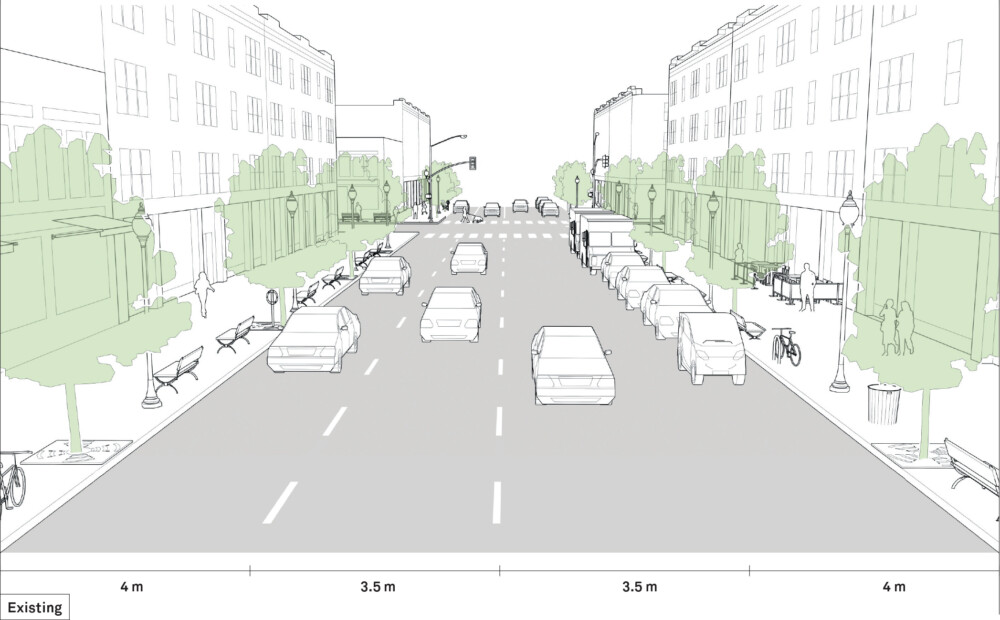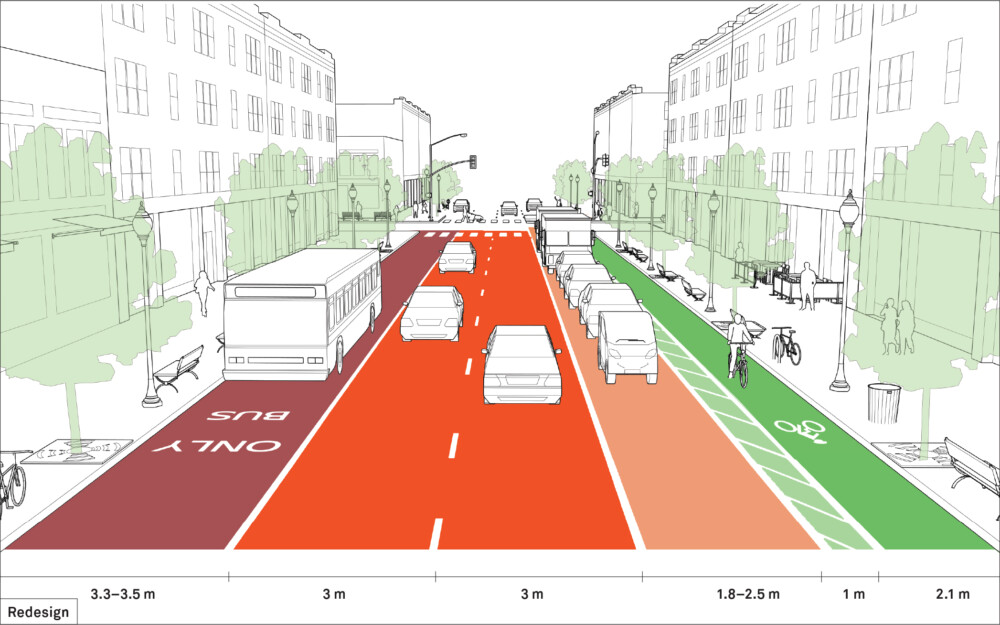-
About Streets
- Introduction
- Defining Streets
-
Shaping Streets
- The Process of Shaping Streets
- Aligning with City and Regional Agendas
- Involving the Right Stakeholders
- Setting a Project Vision
- Communication and Engagement
- Costs and Budgets
- Phasing and Interim Strategies
- Coordination and Project Management
- Implementation and Materials
- Management
- Maintenance
- Institutionalizing Change
- Measuring and Evaluating Streets
-
Street Design Guidance
- Designing Streets for Great Cities
- Designing Streets for Place
-
Designing Streets for People
- Utilities and Infrastructure
- Operational and Management Strategies
- Design Controls
-
Street Transformations
- Streets
-
Intersections
- Intersection Design Strategies
- Intersection Analysis
- Intersection Redesign
- Mini Roundabout
- Small Raised Intersection
- Neighborhood Gateway Intersection
- Intersection of Two-Way and One-Way Streets
- Major Intersection: Reclaiming the Corners
- Major Intersection: Squaring the Circle
- Major Intersection: Cycle Protection
- Complex Intersection: Adding Public Plazas
- Complex Intersection: Improving Traffic Circles
- Complex Intersection: Increasing Permeability
- Resources
Global Street Design Guide
-
About Streets
- Introduction
- Defining Streets
-
Shaping Streets
Back Shaping Streets
- The Process of Shaping Streets
- Aligning with City and Regional Agendas
- Involving the Right Stakeholders
- Setting a Project Vision
- Communication and Engagement
- Costs and Budgets
- Phasing and Interim Strategies
- Coordination and Project Management
- Implementation and Materials
- Management
- Maintenance
- Institutionalizing Change
-
Measuring and Evaluating Streets
Back Measuring and Evaluating Streets
-
Street Design Guidance
-
Designing Streets for Great Cities
Back Designing Streets for Great Cities
-
Designing Streets for Place
Back Designing Streets for Place
-
Designing Streets for People
Back Designing Streets for People
- Comparing Street Users
- A Variety of Street Users
-
Designing for Pedestrians
Back Designing for Pedestrians
- Designing for Cyclists
-
Designing for Transit Riders
Back Designing for Transit Riders
- Overview
- Transit Networks
- Transit Toolbox
-
Transit Facilities
Back Transit Facilities
-
Transit Stops
Back Transit Stops
-
Additional Guidance
Back Additional Guidance
-
Designing for Motorists
Back Designing for Motorists
-
Designing for Freight and Service Operators
Back Designing for Freight and Service Operators
-
Designing for People Doing Business
Back Designing for People Doing Business
-
Utilities and Infrastructure
Back Utilities and Infrastructure
- Utilities
-
Green Infrastructure and Stormwater Management
Back Green Infrastructure and Stormwater Management
-
Lighting and Technology
Back Lighting and Technology
-
Operational and Management Strategies
Back Operational and Management Strategies
- Design Controls
-
Street Transformations
-
Streets
Back Streets
- Street Design Strategies
- Street Typologies
-
Pedestrian-Priority Spaces
Back Pedestrian-Priority Spaces
-
Pedestrian-Only Streets
Back Pedestrian-Only Streets
-
Laneways and Alleys
Back Laneways and Alleys
- Parklets
-
Pedestrian Plazas
Back Pedestrian Plazas
-
Pedestrian-Only Streets
-
Shared Streets
Back Shared Streets
-
Commercial Shared Streets
Back Commercial Shared Streets
-
Residential Shared Streets
Back Residential Shared Streets
-
Commercial Shared Streets
-
Neighborhood Streets
Back Neighborhood Streets
-
Residential Streets
Back Residential Streets
-
Neighborhood Main Streets
Back Neighborhood Main Streets
-
Residential Streets
-
Avenues and Boulevards
Back Avenues and Boulevards
-
Central One-Way Streets
Back Central One-Way Streets
-
Central Two-Way Streets
Back Central Two-Way Streets
- Transit Streets
-
Large Streets with Transit
Back Large Streets with Transit
- Grand Streets
-
Central One-Way Streets
-
Special Conditions
Back Special Conditions
-
Elevated Structure Improvement
Back Elevated Structure Improvement
-
Elevated Structure Removal
Back Elevated Structure Removal
-
Streets to Streams
Back Streets to Streams
-
Temporary Street Closures
Back Temporary Street Closures
-
Post-Industrial Revitalization
Back Post-Industrial Revitalization
-
Waterfront and Parkside Streets
Back Waterfront and Parkside Streets
-
Historic Streets
Back Historic Streets
-
Elevated Structure Improvement
-
Streets in Informal Areas
Back Streets in Informal Areas
-
Intersections
Back Intersections
- Intersection Design Strategies
- Intersection Analysis
- Intersection Redesign
- Mini Roundabout
- Small Raised Intersection
- Neighborhood Gateway Intersection
- Intersection of Two-Way and One-Way Streets
- Major Intersection: Reclaiming the Corners
- Major Intersection: Squaring the Circle
- Major Intersection: Cycle Protection
- Complex Intersection: Adding Public Plazas
- Complex Intersection: Improving Traffic Circles
- Complex Intersection: Increasing Permeability
- Resources
- Guides & Publications
- Global Street Design Guide
- Designing Streets for People
- Designing for Motorists
- Travel Lanes
Travel Lanes


Highway lane-width standards, when applied in cities, result in overly wide, undifferentiated lanes that perform poorly at most times of the day, with speeding at off peak times and lane-splitting during peak traffic periods. Reducing lane width to 3 m or less promotes safe driving speeds in an urban environment.
Travel Lane Width
Wide travel lanes have been favored in some places to create a more forgiving environment for drivers, especially in high-speed environments where narrow lanes may feel uncomfortable or increase potential for side-swipe collisions. Lane widths of less than 3.5 m have been assumed to decrease traffic flow and capacity, a claim that new research refutes.1
Lane widths of 3 m are appropriate in urban areas and have a positive impact on street safety without impacting traffic operations. For designated truck or transit routes, one travel lane of 3.3 m may be used in each direction. In select cases, narrower travel lanes of 2.7–3 m can be effective as through lanes in conjunction with a turn lane.2 Lanes greater than 3 m are discouraged as they enable unintended speeding and double parking, and consume valuable right-ofway at the expense of other modes.
Restrictive policies that favor the use of wide travel lanes have no place in constrained urban settings, where every centimeter counts. Research has shown that narrower lane widths can effectively manage speeds without decreasing safety, and that wider lanes do not correlate to safer streets.3 Moreover, wider travel lanes increase exposure and crossing distance for pedestrians.4 Lane width should be considered within the overall assemblage of the street.
Multilane Roadways
In multi-lane roadways where transit or freight vehicles are present, one wider travel lane may be provided. The wider lane should be the outside lane, curbside or next to parking. Inside lanes should continue to be designed at the minimum possible width at 3 m or less.
Parking Lane Width
Parking lane widths of 1.8–2.5 m are recommended. Cities are encouraged to demarcate the parking lane to indicate to drivers how close they are to parked cars.
Footnotes
1. Theo Petrisch, “The Truth about Lane Widths,” The Pedestrian and Bicycle Information Center, accessed June 6, 2016, http://www.pedbikeinfo.org/data/library/details.cfm?id=4348
2. Research suggests that lane widths of less than 12 feet on urban and suburban arterials do not increase crash frequencies.
Ingrid Potts, Douglas W. Harwood, and Karen R. Richard, “Relationship of Lane Width to Safety on Urban and Suburban Arterials,” (paper presented at the TRB 86th Annual Meeting, Washington, DC, January 21–25, 2007): 1–6.
3. Eric Dumbaugh and Wenhao Li, “Designing for the Safety of Pedestrians, Cyclists, and Motorists in Urban Environments.” Journal of the American Planning Association 77 (2011): 70.
4. Previous research has shown various estimates of relationship between lane width and travel speed. One account estimated that each additional foot (0.3 m) of lane width related to a 2.9 mph (4.7 km/h) increase in driver speed.
Kay Fitzpatrick, Paul Carlson, Marcus Brewer, and Mark Wooldridge, “Design Factors That Affect Driver Speed on Suburban Arterials,” Transportation Research Record: Journal of the Transportation Research Board 1751 (2000):18–25.
Adapted by Global Street Design Guide published by Island Press.